- Home
- A. G. Riddle
Genome (The Extinction Files Book 2) Page 2
Genome (The Extinction Files Book 2) Read online
Page 2
Below the map was the decrepit coffee machine. Peyton desperately wanted a cup, but she didn’t dare turn the noisy thing on. Her mother lay only a few feet away, on the other small bed in the office, sleeping soundly. Lin had slept very little of late—and she had barely allowed anyone else to, either.
Peyton threw the blanket off and pulled a thick sweater on. She slipped into her pants and placed a small glass heart in her pocket. The item was the only personal effect she had brought with her from Atlanta. It was all she had left of Desmond. She carried it with her to remind her why she was here—and to keep going, no matter what.
Quietly, she opened the door and stepped out into the ship’s cargo hold, squinting momentarily at the bright lights. A bank of computer stations lay just beyond the office, with a dozen technicians peering at large screens, typing, sipping coffee, and occasionally leaning back in their task chairs. Five research scientists hovered over them, pointing at the images and text displayed.
“Could have diverged before AMH.”
“Or an isolated population—i.e. floresiensis.”
“We could call it Homo beagalis—”
“We’re not naming anything yet, ladies and gentlemen. It’s specimen 1644—that’s what the researchers on the Beagle labeled it, and that’s its name for now.”
Peyton recognized the last voice: Dr. Nigel Greene. He was an evolutionary biologist leading the team analyzing the samples brought up from the Beagle.
At the sound of Peyton’s footfalls on the metal floor, he turned and, seeing her, immediately smiled.
“Sounds like you all won the Super Bowl,” she said.
The British scientist cocked his head. “What’s that?”
“Nothing.” She nodded toward the screens. “Found something?”
He raised his eyebrows. “Indeed.”
Nigel made a show of telling the other scientists and techs to “carry on,” then lightly touched Peyton’s back, corralling her to an empty computer workstation. He spoke in a hushed tone, as if what he was about to say was a closely held secret.
“We just received the first data set back from Rubicon. The samples from specimen group one are all from extinct species—as your mother predicted.” He leaned over and worked the computer, pulling up an image of a long bone lying in a metal case. “We suspected specimen 1642 was a femur bone from a canid species. We were right.”
An image appeared of what looked like a large wolf.
“It’s from a dire wolf. They inhabited North America from roughly 125,000 years ago until their extinction 10,000 years ago. Some of the best fossils have been found outside Los Angeles, at the La Brea Tar Pits.” Nigel studied the artist’s rendering. “They were magnificent creatures. Imagine a wolf weighing roughly 150 pounds with a massive head and jaws. They died out with the Pleistocene megafauna, near the end of the last glaciation. Or so we thought.”
He brought up a graph that Peyton recognized as a carbon-dating test.
“The specimen recovered from the Beagle is roughly 9,500 years old,” he said. “Which means it came from an animal that walked the Earth 800 years after the youngest known dire wolf. That species’ timeline just got rewritten.”
Nigel worked the mouse. “That’s not all.”
An image of four rib bones appeared.
“Any guesses?”
Peyton exhaled. She really, really wanted that coffee.
She had requested that Nigel and his team keep her in the loop on what they found. It was outside her area of expertise, but it was in her nature to throw herself into her work, and she had always been naturally curious, especially when it came to questions of science. And deep down, she held out hope that knowing what was down there would increase her chances of stopping Yuri—and getting Desmond back. Now she sensed that Nigel had another motive for describing what he had found, though she had no idea what that was.
“I’m guessing they’re the bones of an extinct species.”
“Ha. Yes, but which—”
“Nigel, I have no clue.”
“Really?”
“I’m an epidemiologist. My expertise is keeping us from going extinct.”
Her rebuff did nothing to dampen his enthusiasm. “Right you are. Well, anyway. The fossils are from an American lion.”
Peyton had never heard of that species either. She again wondered what he was working up to.
An artist’s rendering appeared on the screen. It looked to Peyton exactly like an African lion, only much larger.
Nigel spoke in a professional tone, as if he were narrating a National Geographic special just for Peyton. “The American lions emerged about 340,000 years ago. We think they diverged from the Eurasian cave lion at some point and made their way across the Bering Strait to North America, where they diverged further. They were giants. They’re still one of the largest types of cats to have ever existed—roughly 25 percent larger than modern African lions.”
He minimized the screen and turned to Peyton. “Like the dire wolf and many other large mammals, they became extinct at the end of the Pleistocene. The youngest fossil dates to 11,355 before present. Or so we thought. These bones are far younger—around 9,500 years old, like the dire wolf. We’re assuming they were recovered from the same site, possibly the La Brea Tar Pits, which is the most abundant source of American lion fossils.”
He paused. “Taken together, the fossils imply an interest in the Quaternary extinction event.”
Peyton squinted—she wasn’t following.
“Ah, that’s the extinction of mostly large animals around the time the last ice age ended. It’s perhaps one of the greatest scientific mysteries—well, at least for an evolutionary biologist like myself.” Nigel held his hands out. “Imagine the world roughly 12,000 years ago—it was a land of giants. Mastodons. Saber-toothed cats. Giant condors. Ground sloths. Saber-toothed salmon. At the same time humans were founding the city of Jericho, massive beasts walked the Earth, dotted the skies, and swam in the oceans. Some had been around a lot longer than us—tens of millions of years. Then, in the blink of an eye—in evolutionary timescales—they were gone.”
Nigel paused dramatically.
“For years, researchers have desperately tried to figure out why. Is that what they were studying on board the Beagle? Did they find the source of the Quaternary extinction event?”
Peyton shifted uncomfortably. “Hard to say, Nigel.”
“Because you don’t know?”
For the most part, Lin had kept the research team in the dark. She had told Peyton a bit more, but not much more. Only that the scientists on the Beagle had been testing what they called a “second theory of evolution”—a revolutionary hypothesis that would radically change our understanding of what it means to be human, a discovery as fundamental as gravity. For whatever reason, Lin hadn’t shared that information with Nigel or the other researchers.
Peyton realized then why Nigel was walking her through it. He wanted to know what Lin had told her. He was hoping to learn exactly what the Beagle researchers were studying. That put her in an impossible position. She needed to speak with her mother.
“Is that all, Nigel?”
The pudgy biologist grew animated again. He turned back to the computer and brought up a photo of a small human skull. “Saved the best for last. We were able to extract a DNA sample from a tooth. It’s human, but the genome isn’t a match for ours.”
“Everyone has a different genome.”
“True enough, but each species—and subspecies—has a different… template, if you will. Our genome is 98.8% identical to chimpanzees. Every person and chimp has different values in their sequence, but the framework is the same: twenty-three chromosomes. Neanderthals are even more similar to us: their genome is a 99.5% match to our own.”
Nigel pointed to the picture of the skull. “And this mystery human is even more closely related to us. A 99.6% match. That’s extraordinary. A genome we’ve never seen before. And this person died around 9,000
years ago. They are perhaps our closest extant ancestor—or cousin. We don’t know if they diverged from the human family tree before we evolved or after.”
He studied the picture. “We’re assuming it was recovered near or at the same site as the lion and wolf, but that’s just guesswork.” He glanced toward the office Peyton shared with her mother. “It would be extremely helpful to know what you all have found in the offices—any notes associated with the bones. Maps of where they were found…”
“It’s not my call, Nigel.”
“Perhaps, but she listens to you. Those bones have been down there since the Beagle sank thirty years ago. Who knows when they were recovered. And what else they found. We need context to figure out what we’re dealing with here.”
Peyton shook her head.
“Please, Peyton. This is vitally important. I’m not sure you appreciate the gravity of this discovery. We’re literally rewriting history here.”
A sharp voice startled Peyton. “We’re not rewriting history.”
Lin Shaw stood only feet from them. She looked haggard, but her voice betrayed none of her weariness. She walked closer, glanced at the image of the skull, then looked away, as if she found it unremarkable. She focused on Nigel. “History is history, Dr. Greene. It’s only forgotten and rediscovered. In our case, we’re merely recovering what the brave crew of the Beagle rediscovered.”
“And what exactly is that?”
“You’ll know when we have all the pieces. And it’s time we recovered more of those pieces. Have the Russians prepare to launch the submersible.”
Nigel glanced at his watch. “It’s only been six hours since the last dive.”
“Your point?”
“The crew is exhausted—”
“I’ll see to crew morale. Get it done, Dr. Greene.”
His gaze drifted to the floor as he nodded. “Yes, ma’am.”
To Peyton, she said, “Coffee?”
Inside the office, Lin turned the old coffeemaker on.
“He’s asking questions, Mom.”
Lin ran a finger down the length of the map of the Beagle, as if mentally walking through the wrecked submarine, trying to decide which compartment to explore next.
“What are you going to tell them?”
“Nothing,” Lin whispered, still staring at the map.
“They want to know exactly what’s down there. What these experiments were about. And frankly, so do I.” Peyton glanced out the window to make sure no one was lurking near the office. “This… code in the human genome—what is it? What does it do? How will it stop the Citium?”
Lin didn’t make eye contact. “Do you trust me?”
“Yes.” Peyton paused. “But obviously there’s somebody out there you don’t trust.”
“You’re wrong.”
“About what?”
“There isn’t somebody out there I don’t trust. There’s nobody out there I do trust. The only person I trust is standing in this room.”
Chapter 2
Desmond hated the prison, but he had to admit that it was effective. His cell was an outdoor pen surrounded by a tall electric fence. The interior was hard, dusty earth with a few patches of grass. A second electric fence lay ten feet beyond the first. Guards marched by every two hours, and cameras atop poles watched him in the minutes in between. Large canopies, printed with island foliage, towered above, providing some relief from the South Pacific sun, but more importantly, they hid Desmond from the satellites he knew were searching for him and the Citium.
At the center of the pen, Desmond stretched out on a cot, trying not to think about Peyton. Trying and failing. There was too much left unsaid between them. But it was more than that. He was worried about her. He would have traded the possibility of never talking with her again just to know that she was okay, that she had survived the carnage on the Isle of Citium. Desmond had sacrificed himself that morning—allowed himself to be captured in hopes that Avery might complete their mission—distributing a cure to the Citium’s pandemic. He wondered if Avery had succeeded, if the billions infected had been saved. Or if the world had collapsed. Or both.
Desmond’s brother, Conner McClain, visited at sunset each day. He sat on a folding chair inside the outer fence. Some days he talked, others he read, and occasionally he sat in silence. Desmond never responded. He simply stared out at the beach below.
As the blue horizon once again swallowed the sun, Desmond wondered what they were waiting for.
A mile away, Conner walked to the silver double doors and slid his hand into the palm reader in the wall. When the device beeped, he leaned closer and stared into the retinal scanner.
The doors opened, revealing a small room with brushed metal walls. Another set of closed metal doors lay ahead. Conner waited while the scanners embedded in the ceiling and walls checked him for any weapons, explosives, and unidentified devices.
Finally, the double doors parted, revealing a long room with illuminated tiles on the floor and ceiling, providing an even, white glow. Rows of servers and monitoring equipment spread out before him, and lights blinked—red, green, yellow, and blue, like an orchestra playing with no sound. Several technicians milled about, checking the equipment and slipping into the enclosed cages to fix any problems, their faces obscured by the wire mesh, like penitents in confessionals.
To Conner, the analogy was fitting. This place was a sanctuary. A place of reverence, of rebirth. A fresh start for him and the entire human race.
He walked past the servers to the glass wall on the opposite side. The chamber beyond was vast and dark, a grotto with gunmetal gray walls and a thin white cloud at the bottom, floating above a sea of liquid. A hundred black towers rose through the cloud, like skyscrapers with no windows, a model of a city of the future.
Conner admired his creation. Soon Rook would come online, and he would be free.
Outside, Conner marched along a dirt path. Camouflaged canopies hung overhead, blocking some of the sun’s oppressive heat, but also serving a far more important purpose: hiding the Citium base. US, Australian, Russian, and Japanese ships and their drones were scouring the South Pacific, trying to find Yuri and Conner. They were getting closer.
At Desmond’s pen, Conner paused by the outer gate, hoping his brother would make some reaction. He simply stared at the canopy above.
Conner opened the outer gate. Desmond still didn’t stir.
Since Conner had brought him here two weeks ago, Desmond hadn’t said a word. Hadn’t requested food, or shelter from the elements.
Yesterday they had interrogated him—against Conner’s wishes. It was a desperate act that had pained Conner to watch. But they’d had to. Time was running out—and too much was at stake.
Under the influence of the chemical agent, Desmond had revealed that he hadn’t recovered the memory of what he’d done with Rendition. He had hidden the information somewhere else—for a time when he was ready to use it.
Conner desperately wanted to reach his brother and bring him back into the Citium. Their cause depended on it. But it was more than that. Desmond was his only true human connection; Conner felt alone without him. Mentally, he felt like he did before Desmond found him in Australia: hopeless and isolated.
Desmond had been in the same place before they reunited. His only solace in those days was books. They had helped him escape his childhood. And one of his favorite books was Treasure Island by Robert Louis Stevenson.
Conner opened another of Stevenson’s classics—The Strange Case of Dr Jekyll and Mr Hyde—and began to read.
When the sun had set and the moonlight was too dim to read by, Conner got up, locked the gate behind him, and trudged back down the path. As usual, Desmond hadn’t said a word, hadn’t moved or even acknowledged his brother’s presence. That hurt most of all.
Inside the camouflaged building, Conner made his way to the programmers’ team room. As always, it was a pigsty. The trash bin overflowed with crushed cans of energy drinks and microwav
e wrappers. Server towers with their side panels removed lay on a long table, their silicon guts spilling out. Balled-up papers dotted the floor like golf balls at a driving range.
Conner knew what one of those papers was. The first time he had entered the room, he had seen his own face printed on a sheet tacked to the wall. The scars that covered his forehead, left cheek, and chin were partially covered with Borg implants. The words Resistance Is Futile were printed below the image. He wasn’t sure if they referred to his management style or his plan for humanity, and he didn’t care. He had been ridiculed his entire life. He was used to it.
But soon it would end. The poster that mocked him confirmed that the programmers knew the strength of his resolve.
Them taking it down confirmed that they were scared of him.
The lead developer saw Conner’s reflection in the plate glass window. He ripped his headphones off, spun his office chair around, and stood. The man’s name was Byron, and he was tall and gangly, with pasty white skin.
“Where are we?” Conner demanded.
“On which one?” Byron asked.
“Hughes. The Labyrinth.”
The programmer swallowed. “It’s impossible.”
“Your job is to do the impossible,” Conner snapped.
“Look, this is like a black box inside a black box.”
“Meaning?”
“Meaning it’s like—”
“I don’t care what it’s like. Be specific. What’s the problem?”
“The problem is that we have no idea how the Labyrinth Reality app works.”
“So do whatever you do—reverse engineer it. Deobfuscate it.”
“We did that. Five days ago. That’s not the issue.”
“What is?”
“Location awareness.”
“I don’t follow.”
Byron rubbed the bridge of his nose, as if dreading having to explain. “The app sends a code to the implant in Hughes’s brain that unlocks his memories, but it only does it at certain locations. At first we assumed it was using the phone’s built-in location programming interface, but now we know it’s double-checking with an external server. It’s probably using cell towers, or more likely a private satellite to verify—”

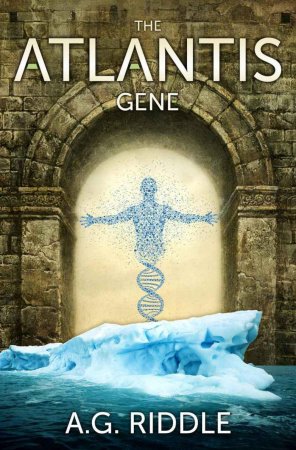 The Atlantis Gene: A Thriller
The Atlantis Gene: A Thriller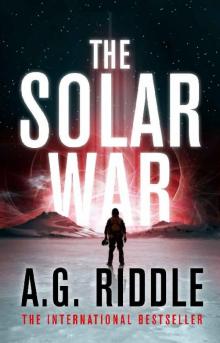 The Solar War (The Long Winter Book 2)
The Solar War (The Long Winter Book 2) The Extinction Files Box Set
The Extinction Files Box Set The Atlantis Trilogy Box Set- The Complete Series
The Atlantis Trilogy Box Set- The Complete Series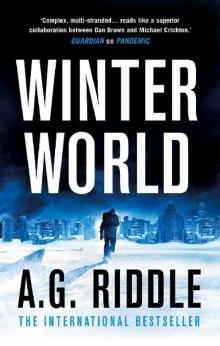 Winter World
Winter World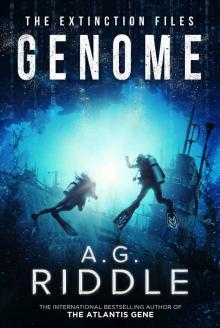 Genome
Genome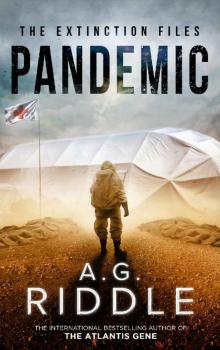 Pandemic (The Extinction Files Book 1)
Pandemic (The Extinction Files Book 1)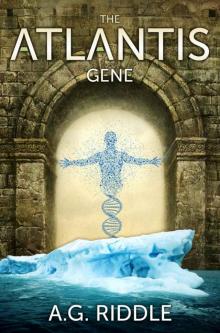 The Atlantis Gene: A Thriller (The Origin Mystery, Book 1)
The Atlantis Gene: A Thriller (The Origin Mystery, Book 1) Departure
Departure Genome (The Extinction Files Book 2)
Genome (The Extinction Files Book 2) The Atlantis World (The Origin Mystery, Book 3)
The Atlantis World (The Origin Mystery, Book 3) The Atlantis Plague: A Thriller (The Origin Mystery, Book 2)
The Atlantis Plague: A Thriller (The Origin Mystery, Book 2)